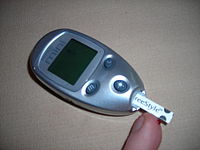
Photo from wikipedia
Hypoglycemia is a major complication associated with insulin therapy in people with diabetes that could cause life-threatening conditions if untreated. Glucagon, a counter-acting hormone, is thus administered for rescue of… Click to show full abstract
Hypoglycemia is a major complication associated with insulin therapy in people with diabetes that could cause life-threatening conditions if untreated. Glucagon, a counter-acting hormone, is thus administered for rescue of severe hypoglycemia. However, due to the instability of glucagon, only limited medications are available for emergency use, which are unsuitable for patients with hypoglycemia unawareness or with the inability to self-administer, especially during sleep (namely, nocturnal hypoglycemia). To prevent unattended and extended hypoglycemia, we designed a "smart" composite microneedle (cMN) patch capable of stabilizing glucagon, sensing hypoglycemia, and delivering glucagon automatically on demand. In this design, native glucagon was encapsulated in glucose-responsive microgels containing a glucagon-stabilizing component rationally selected by molecular dynamics (MD) simulation. A cMN patch was then prepared by incorporating the glucagon microgels with poly(methyl vinyl ether-alt-maleic anhydride) (PMVE-MAH) and poly(ethylene glycol) (PEG) followed by thermal cross-linking. The rationally designed zwitterionic polymer-based microgels preserved the native structure of glucagon and prevented heat-induced fibrillation evidenced by RP-HPLC, circular dichroism, and transmission electron microscopy. MD simulations suggested that the polymeric microgels stabilized glucagon by inhibition of oligomer formation via peptide-polymer noncovalent interactions. The polymer formed multiple hydrogen bonds with the polar and charged amino acid residues of the glucagon molecule, shielding the peptide surface from aggregation. In vivo efficacy studies using streptozotocin-induced type 1 diabetic (T1D) rats demonstrated that the glucagon-loaded cMN patch could prevent hypoglycemia induced by insulin overdose during a 12 h period. The results suggest that this new glucagon "smart" patch may be a promising system for improving the quality of life of those suffering from nocturnal hypoglycemia and hypoglycemia unawareness.
Journal Title: ACS applied materials & interfaces
Year Published: 2022
Link to full text (if available)
Share on Social Media: Sign Up to like & get
recommendations!